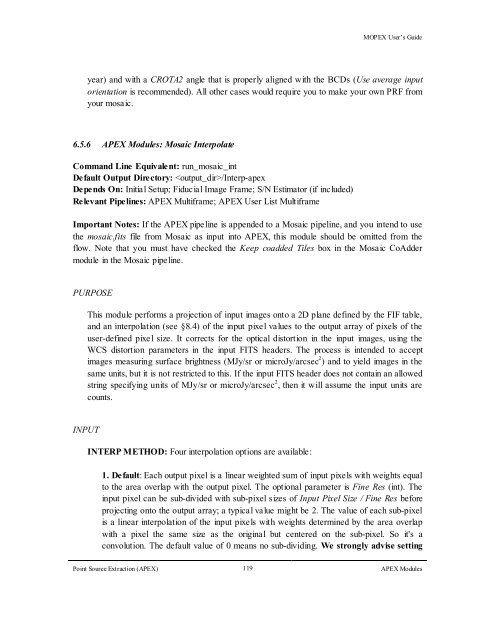Create successful ePaper yourself
Turn your PDF publications into a flip-book with our unique Google optimized e-Paper software.
<strong>MOPEX</strong> User’s <strong>Guide</strong><br />
year) and with a CROTA2 angle that is properly aligned with the BCDs (Use average input<br />
orientation is recommended). All other cases would require you to make your own PRF from<br />
your mosaic.<br />
6.5.6 APEX Modules: Mosaic Interpolate<br />
Command Line Equivalent: run_mosaic_int<br />
Default Output Directory: /Interp-apex<br />
De pe nds On: Initia l Setup; Fiducial Image Frame; S/N Estimator (if included)<br />
Relevant Pipelines: APEX Multiframe; APEX User List Multiframe<br />
Important Notes: If the APEX pipeline is appended to a Mosaic pipeline, and you intend to use<br />
the mosaic.fits file from Mosaic as input into APEX, this module should be omitted from the<br />
flow. Note that you must have checked the Keep coadded Tiles box in the Mosaic CoAdder<br />
module in the Mosaic pipeline.<br />
PURPOSE<br />
This module performs a projection of input images onto a 2D plane defined by the FIF table,<br />
and an interpolation (see §8.4) of the input pixel values to the output array of pixels of the<br />
user-defined pixel size. It corrects for the optical distortion in the input images, using the<br />
WCS distortion parameters in the input FITS headers. The process is intended to accept<br />
images measuring surface brightness (MJy/sr or microJy/arcsec 2 ) and to yield images in the<br />
same units, but it is not restricted to this. If the input FITS header does not contain an allowed<br />
string specifying units of MJy/sr or microJy/arcsec 2 , then it will assume the input units are<br />
counts.<br />
INPUT<br />
INTERP METHOD: Four interpolation options are available:<br />
1. Default: Each output pixel is a linear weighted sum of input pixels with weights equal<br />
to the area overlap with the output pixel. The optional parameter is Fine Res (int). The<br />
input pixel can be sub-divided with sub-pixel sizes of Input Pixel Size / Fine Res before<br />
projecting onto the output array; a typical value might be 2. The value of each sub-pixel<br />
is a linear interpolation of the input pixels with weights determined by the area overlap<br />
with a pixel the same size as the original but centered on the sub-pixel. So it's a<br />
convolution. The default value of 0 means no sub-dividing. We strongly advise setting<br />
Point Source Extraction (APEX) 119<br />
APEX Modules





